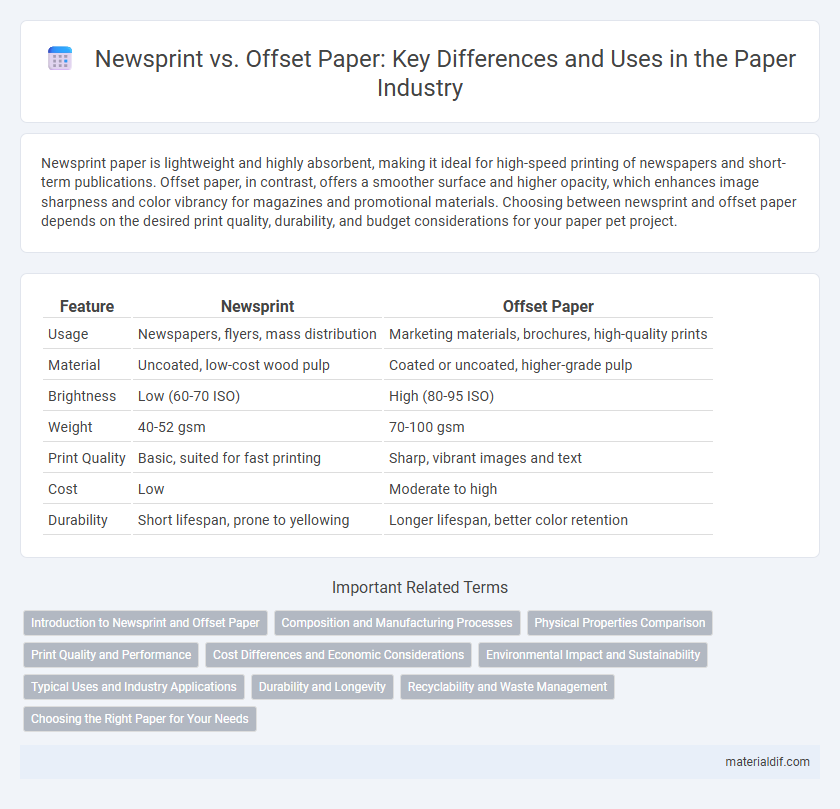Newsprint paper is lightweight and highly absorbent, making it ideal for high-speed printing of newspapers and short-term publications. Offset paper, in contrast, offers a smoother surface and higher opacity, which enhances image sharpness and color vibrancy for magazines and promotional materials. Choosing between newsprint and offset paper depends on the desired print quality, durability, and budget considerations for your paper pet project.
Table of Comparison
| Feature | Newsprint | Offset Paper |
|---|---|---|
| Usage | Newspapers, flyers, mass distribution | Marketing materials, brochures, high-quality prints |
| Material | Uncoated, low-cost wood pulp | Coated or uncoated, higher-grade pulp |
| Brightness | Low (60-70 ISO) | High (80-95 ISO) |
| Weight | 40-52 gsm | 70-100 gsm |
| Print Quality | Basic, suited for fast printing | Sharp, vibrant images and text |
| Cost | Low | Moderate to high |
| Durability | Short lifespan, prone to yellowing | Longer lifespan, better color retention |
Introduction to Newsprint and Offset Paper
Newsprint is a low-cost, non-archival paper primarily used for printing newspapers with high opacity and good ink absorbency, making it ideal for mass circulation. Offset paper, designed specifically for offset printing technology, offers a smoother surface, higher brightness, and improved durability, ensuring sharper images and text quality. Both papers are tailored to different printing needs, with newsprint optimized for economy and offset paper optimized for print quality and longevity.
Composition and Manufacturing Processes
Newsprint is composed primarily of mechanical pulp derived from softwood fibers, resulting in a relatively low basis weight and lower brightness suited for short-term use, while offset paper utilizes chemical pulp with a higher degree of bleaching and refining, leading to increased strength and whiteness essential for high-quality printing. The manufacturing process of newsprint emphasizes speed and cost-efficiency, often involving minimal bleaching and filling, whereas offset paper production involves extensive bleaching, sizing, and calendaring to enhance surface smoothness, opacity, and ink receptivity. Variations in fiber treatment and additive application during manufacturing directly impact the properties such as absorbency, durability, and print clarity crucial for each paper type's intended application.
Physical Properties Comparison
Newsprint is lighter and more porous, typically featuring a basis weight of 40-52 gsm and a lower brightness level around 40-55%, making it suitable for short-term publication use. Offset paper, with a heavier basis weight range of 60-120 gsm and higher brightness levels exceeding 80%, offers superior opacity, smoothness, and durability for high-quality printing applications. The physical differences impact ink absorption, print sharpness, and overall print longevity, with offset paper providing enhanced performance for detailed graphics and extended publication lifespan.
Print Quality and Performance
Newsprint offers a cost-effective solution with moderate print quality, suitable for short-term publications but prone to faster ink absorption and grainy textures. Offset paper provides superior print clarity, sharper image reproduction, and better ink holdout, enhancing visual appeal and durability in high-quality print jobs. Its performance in offset printing presses ensures consistent feed, preventing smudging and paper jams compared to newsprint.
Cost Differences and Economic Considerations
Newsprint is generally more cost-effective than offset paper due to its lower production expenses and use of recycled fibers, making it ideal for high-volume, short-term publications like newspapers. Offset paper, while more expensive, offers superior quality, durability, and brightness, which justifies its higher cost in applications such as brochures and magazines where visual appeal is critical. Economic considerations must factor in the intended use, print run length, and quality requirements to balance cost-efficiency with product performance.
Environmental Impact and Sustainability
Newsprint typically has a lower environmental impact than offset paper due to its higher usage of recycled fibers and less bleaching, which reduces chemical pollutants. Offset paper, while often involving virgin fibers and more intensive processing, can be certified for sustainability through certifications like FSC and PEFC, promoting responsible forest management. Both paper types contribute differently to sustainability goals depending on sourcing, production methods, and end-of-life recyclability rates.
Typical Uses and Industry Applications
Newsprint is predominantly used for printing newspapers, inserts, and flyers due to its lightweight and cost-effectiveness, making it ideal for high-volume, short-term publications. Offset paper is favored in commercial printing sectors for brochures, magazines, catalogs, and promotional materials thanks to its superior surface quality and ink absorption properties that enhance image clarity. Industries such as publishing, advertising, and packaging rely on offset paper for professional-grade output, whereas newsprint serves mass media and large-scale distribution needs.
Durability and Longevity
Newsprint is generally less durable and has a shorter lifespan compared to offset paper due to its low-quality pulp and high acidic content causing faster yellowing and brittleness. Offset paper, made from higher-grade fibers and treated for acidity, offers superior strength, resistance to tearing, and longevity, making it ideal for archival purposes. The enhanced durability of offset paper supports sustained print quality and prolonged usability in professional printing applications.
Recyclability and Waste Management
Newsprint exhibits higher recyclability rates due to its lower ink density and minimal finishing treatments compared to offset paper, facilitating more efficient fiber recovery in recycling processes. Offset paper, commonly coated and treated for enhanced print quality, presents challenges in waste management, often requiring specialized recycling techniques to separate coatings and inks. Effective waste management strategies prioritize the use of newsprint for sustainable paper cycles, reducing landfill contributions and promoting material reuse within the paper industry.
Choosing the Right Paper for Your Needs
Newsprint offers an affordable and lightweight option ideal for daily newspapers and short-term publications due to its lower brightness and absorbency. Offset paper provides higher quality with greater brightness, smoothness, and durability, making it suitable for brochures, posters, and professional printing projects. Selecting between newsprint and offset paper depends on factors like budget, print longevity, image quality, and the intended use of the printed material.
Newsprint vs Offset paper Infographic

 materialdif.com
materialdif.com